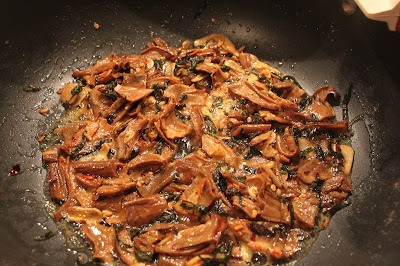 The key ingredient here, as you will have noticed from the title, is porcini mushrooms. These little dudes are a staple of rustic italian cuisine, so much so that they even have festivals celebrating it. Called sagras, these gatherings are quintessentially family affairs where towns, villages and communities typically get together to eat and be merry, often soundtracked by some 70's eurovision reject in a tanktop and silly hair. The sagras aren't limited to mushrooms either - steak, cheese, tomatoes, even focaccia get their own sagra. When it comes to food, Italians have a whole lot to celebrate.
The key ingredient here, as you will have noticed from the title, is porcini mushrooms. These little dudes are a staple of rustic italian cuisine, so much so that they even have festivals celebrating it. Called sagras, these gatherings are quintessentially family affairs where towns, villages and communities typically get together to eat and be merry, often soundtracked by some 70's eurovision reject in a tanktop and silly hair. The sagras aren't limited to mushrooms either - steak, cheese, tomatoes, even focaccia get their own sagra. When it comes to food, Italians have a whole lot to celebrate.Thankfully porcinis, also known as ceps, have become pretty easy to find in the UK now since they can be dried and stored away. You can find them in any italian deli or even Waitrose, and while they can be pricey, they deliver value in flavour. When choosing them, try to get lighter creamy looking ones, and avoid ones that are very dark and crumbly. For the most part a decent pack of porcinis will provide you with enough for a couple of meals, or one seriously packed one.
This recipe throws in a couple of extra little twists in the shape of the chilli and the lemon, which I've increasingly found are hidden stars when it comes to pasta dishes. Particularly when combined with seafood, they create a wonderfully lively combination of flavours. The nice thing of course is that you can adjust the heat to whatever your taste, though I'm a firm believer in even a little bit of spice being a crucial element in this dish.
Creamy Tagliatelle with Porcini Mushrooms
Serves 2
50g butter
2 cloves garlic, thinly sliced
1 teaspoon dried chilli flakes (this will make it pretty spicy, half it if you don't like heat)
10 leaves fresh sage, rinsed, roughly chopped
35g dried Porcini mushrooms
Rind of 1 lemon, peeled (see my note below)
50ml double cream
sea salt and black pepper
Fresh egg tagliatelle, 4-5 baskets per person
Parmesan, freshly grated
4 ice cubes of veal stock (optional, see my blog post about veal stock)
First off, grab your porcinis and dunk them into 250ml of hot water. Just leave them to soak for about 15 to 20 minutes, occasionally just poking them to make sure all the mushrooms are fully soaking.
Peel the lemon rind with a vegetable peeler. The original recipe says to cut the rind into thin strips, but personally, I found that while that did give a lovely flavour, the texture of the rind eventually interfered too much with the dish for me. Personally, I think zest would work absolutely fine and be far less intrusive.
Drain the porcinis, rinse them quickly under the tap and then roughly chop them up. The soaking liquid is gold dust and packed with flavour, however it will have bits of silt and other stuff in there so strain the liquid through a strainer with a cloth in it. Any cloth or muslin will do. Keep the strained liquid to one side.
Put a pan of water on to boil for your pasta. Grab the butter and some olive oil and melt it over medium flame until the foaming settles down.
Lower the heat a little bit and throw in the garlic, sage and chilli. Keep it moving and cook for about 5 minutes or so until it starts to colour.
Throw in the porcini mushrooms and saute them for several minutes until any liquid has evaporated and they're nicely softened.
Add the soaking liquid, and simmer until nearly all the liquid has been re-absorbed by the mushrooms. Now, if you read my last blog post, you might have some lovely veal stock ice cubes stored up in the freezer. This right here is a perfect time to whip them out and drop them straight into the pan.
Again, let the whole thing simmer for a few minutes until it's reduced. You're looking for a lovely dark sauce just nestling around the mushrooms. Once you're happy with it, throw in the cream and the lemon. Again, let it reduce until you get a lovely creamy consistency, as below:
Season the sauce to taste, and reduce the heat to lowest possible setting. Cook the tagliatelle in heavily salted water for 1 minute less than suggested by the packaging (this is a habit of mine), unless it's fresh pasta in which case it's only 3-4 minutes anyway. Reserve some pasta water in a cup or jug (always do this with any pasta sauce), and drain the pasta. Toss it into the sauce, turning it to get every ribbon nicely coated in the sauce. The sauce will often thicken, so add a little pasta water to keep it from getting too claggy. You should be left with a perfectly creamy consistency on the sauce and everything nicely covered.
Get the pasta into warm bowls (tongs are perfect for this), and sprinkle with freshly grated parmesan and cracked black pepper. Tuck in.






















